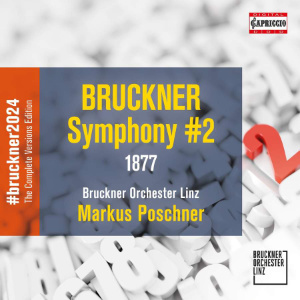
Anton Bruckner (1824-1896)
Symphony No. 2 in C minor WAB 102 (second, 1877 version, ed. Paul Hawkshaw)
Bruckner Orchester Linz/Markus Poschner
rec. 2022, Rehearsal Hall, Musiktheater, Linz, Austria
Capriccio C8089 [52]
This is the first recording of Prof. Paul Hawkshaw’s edition of Bruckner’s Second Symphony in Markus Poschner’s ongoing “Complete Versions” series and is, in the author’s words, “to the best of the editor’s knowledge, the score as Bruckner left it after his revisions in 1877.” This performance is very fast; every movement is significantly swifter than any previous recording, even Paavo Järvi’s propulsive 2019 account with the Berlin Philharmonic, reviewed here, in which he conducts the 1877 version edited by William Carragan and certainly doesn’t hang about but still takes 57 minutes, compared with Poschner’s 52.
| Moderato | Andante | Scherzo | Finale | Total | |
| Poschner | 16:15 | 13:57 | 6:18 | 15:12 | 51:42 |
| Järvi | 17:26 | 17:10 | 6:39 | 15:23 | 56:38 |
As you may see, the major difference is in the pacing of the slow movement. I have in previous reviews expressed great admiration for some of the releases in this series but also in a couple of cases disappointment at what I hear as Poschner’s unduly rushed tempi (the 1873 Third Symphony – review – and the 1876 ‘Romantic’ – review) where I frankly found him to be perfunctory.
There is no doubt that Poschner sets off at a tremendous pace which is very engaging; his strings have no trouble articulating cleanly and the depth of the recorded sound adds to the sense of occasion. The Andante does not feel too fast; the prominence of the persistent pizzicato underlay to the lyrical main subject lends it a stately grandeur and the cumulative power of its ornamented and elaborated restatement in the long crescendo beginning at 8:30 is beautifully gauged. Despite the momentum, Poschner invests the music with great tenderness and the coda is exquisite in poise and delicacy. The Scherzo pushes the boundaries of cohesion but the orchestra is so good it can easily handle the pace – and the Trio is suffused with an airy, bucolic joy, reinforcing the frequent assertion that this symphony is Bruckner’s “paean to Upper Austria”. I love the Scherzo for its untrammelled energy, proleptic and surely the equal of the equivalent movements in Bruckner’s later symphonies and Poschner captures all its confident thrust here. Likewise, the finale is a riot of invention, always pushing forward with new ideas and textures; Poscher’s urgency arguably diminishes the “fantasy” element in favour of generating sheer tension but he is perfectly capable of applying the brakes for lyrical interludes such as the wistful, almost meandering, central development passage of the second theme group from 4:32, building to a splendid climax at 9:36. The coda is similarly powerful and invigorating, bringing the symphony to a triumphant C major peroration.
The editor provides quite a quite detailed musical narrative commentary in his note as well as some interesting background information regarding the circumstances of, and events occurring in, the period in which this most lyrical and optimistic of Bruckner’s symphonies was composed.
This is a performance which, despite the pervasively speeds, achieves a wholly convincing balance between tension and lyricism and must be accounted one of the most successful so far in Poschner’s progress through the various versions of Bruckner’s symphonies.
Ralph Moore
(This review reproduced here by kind permission of The Bruckner Journal.)
Help us financially by purchasing from





















